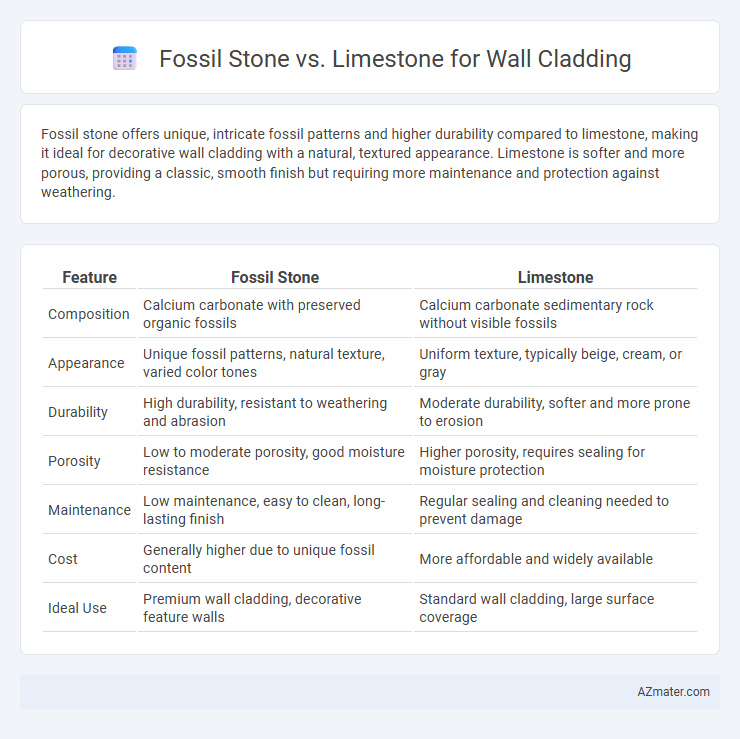Fossil stone offers unique, intricate fossil patterns and higher durability compared to limestone, making it ideal for decorative wall cladding with a natural, textured appearance. Limestone is softer and more porous, providing a classic, smooth finish but requiring more maintenance and protection against weathering.
Table of Comparison
| Feature | Fossil Stone | Limestone |
|---|---|---|
| Composition | Calcium carbonate with preserved organic fossils | Calcium carbonate sedimentary rock without visible fossils |
| Appearance | Unique fossil patterns, natural texture, varied color tones | Uniform texture, typically beige, cream, or gray |
| Durability | High durability, resistant to weathering and abrasion | Moderate durability, softer and more prone to erosion |
| Porosity | Low to moderate porosity, good moisture resistance | Higher porosity, requires sealing for moisture protection |
| Maintenance | Low maintenance, easy to clean, long-lasting finish | Regular sealing and cleaning needed to prevent damage |
| Cost | Generally higher due to unique fossil content | More affordable and widely available |
| Ideal Use | Premium wall cladding, decorative feature walls | Standard wall cladding, large surface coverage |
Introduction to Wall Cladding Materials
Fossil stone and limestone are popular choices for wall cladding due to their durability and aesthetic appeal. Fossil stone offers unique patterns with embedded ancient marine life, adding a natural historical element, while limestone is prized for its uniform texture and light color variations that complement various architectural styles. Both materials provide excellent weather resistance and insulation properties, making them suitable for both interior and exterior wall applications.
What is Fossil Stone?
Fossil stone is a type of sedimentary rock rich in preserved ancient organic remains, primarily marine fossils embedded within the stone, making it unique and visually striking for wall cladding applications. In contrast, limestone is a sedimentary rock mainly composed of calcium carbonate without significant fossil content, offering a more uniform and classic appearance. Fossil stone provides intricate natural patterns and textures due to the fossilized remains, making it a preferred choice for decorative and feature walls where design distinctiveness is desired.
What is Limestone?
Limestone is a sedimentary rock primarily composed of calcium carbonate, commonly formed from marine organisms' skeletal fragments over millions of years. It offers excellent durability and natural aesthetic appeal, making it a popular choice for wall cladding in architectural projects. Compared to fossil stone, limestone provides a more uniform texture and color while maintaining strong weather resistance and versatility in design.
Appearance: Fossil Stone vs Limestone
Fossil stone for wall cladding features unique, intricate patterns created by embedded ancient biological remnants, offering a natural and textured aesthetic that varies significantly between slabs. Limestone presents a more uniform and subtle appearance with soft, muted tones ranging from beige to gray, providing a classic and timeless look for interior or exterior walls. The choice between fossil stone and limestone ultimately depends on the desired visual impact--fossil stone delivers distinct character and complexity, while limestone ensures elegance and simplicity.
Durability and Strength Comparison
Fossil stone exhibits higher durability and strength compared to limestone, making it a more resilient choice for wall cladding in harsh weather conditions. Limestone, while aesthetically pleasing and easier to work with, is more susceptible to erosion and surface wear over time due to its porous nature. The denser composition of fossil stone provides better resistance to mechanical damage and environmental stress, ensuring longer-lasting wall cladding performance.
Maintenance and Care Requirements
Fossil stone wall cladding demands minimal maintenance due to its dense, durable composition, resisting stains and wear with regular sealing every few years to preserve its natural texture. Limestone, being a softer sedimentary rock, requires more frequent sealing and gentle cleaning with pH-neutral agents to prevent acid etching, staining, and erosion from moisture exposure. Proper care for both materials involves avoiding abrasive cleaners and promptly addressing spills to extend their lifespan and maintain aesthetic appeal.
Cost Analysis: Fossil Stone vs Limestone
Fossil stone typically incurs higher initial costs than limestone due to its unique fossil patterns and rarity, making it a premium choice for wall cladding. Limestone offers more affordable pricing, benefiting from widespread availability and easier quarrying processes, which lowers procurement and transportation expenses. Over time, maintenance costs for both materials are comparable; however, limestone's susceptibility to weathering can increase restoration expenses in harsh climates.
Environmental Impact and Sustainability
Fossil stone, sourced from ancient marine deposits, typically requires less processing, resulting in a lower carbon footprint compared to limestone, which often undergoes extensive quarrying and refinement. Limestone extraction can lead to significant habitat disruption and CO2 emissions due to calcination, whereas fossil stone's environmental impact is generally less intensive. Choosing fossil stone for wall cladding supports sustainable building practices by minimizing resource depletion and reducing greenhouse gas emissions associated with material production.
Installation Process and Challenges
Fossil stone for wall cladding requires meticulous cutting techniques due to its embedded shell and skeletal patterns, demanding skilled labor to avoid damage during installation, which can increase labor costs and time. Limestone, being relatively softer and more uniform, allows for easier cutting and installation but poses challenges in durability and susceptibility to weathering, necessitating proper sealing and maintenance. Both materials require precise substrate preparation to ensure long-term adhesion and prevent issues like cracking or detachment.
Choosing the Right Material for Your Project
Fossil stone offers a unique, textured appearance with embedded fossils that create a natural, historical aesthetic ideal for decorative wall cladding. Limestone provides a smoother surface with excellent durability and versatility, suitable for both interior and exterior applications due to its weather-resistant properties. Selecting the right material depends on the desired visual impact, the project's environmental conditions, and maintenance requirements, with fossil stone favored for artistic appeal and limestone preferred for structural longevity.

Infographic: Fossil stone vs Limestone for Wall cladding
 azmater.com
azmater.com